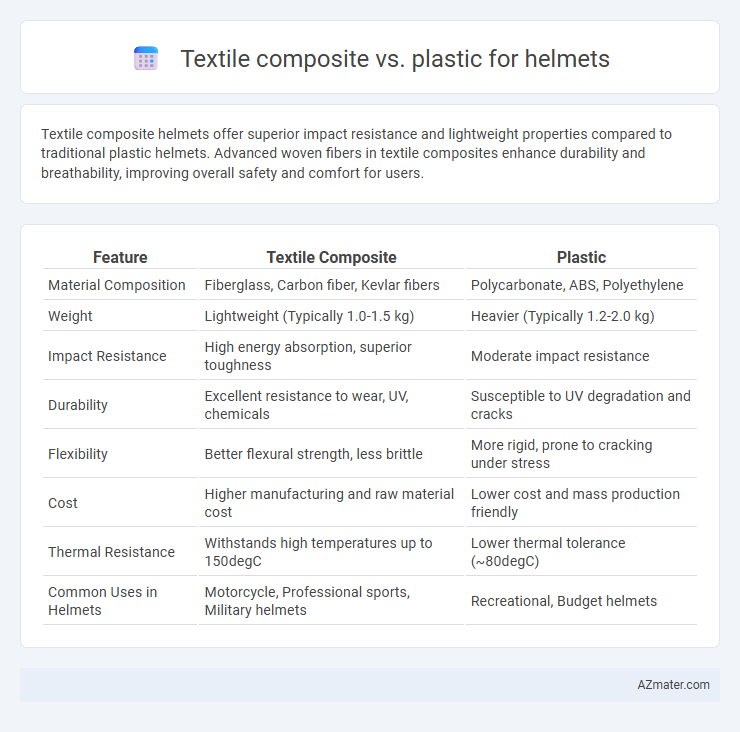Textile composite helmets offer superior impact resistance and lightweight properties compared to traditional plastic helmets. Advanced woven fibers in textile composites enhance durability and breathability, improving overall safety and comfort for users.
Table of Comparison
| Feature | Textile Composite | Plastic |
|---|---|---|
| Material Composition | Fiberglass, Carbon fiber, Kevlar fibers | Polycarbonate, ABS, Polyethylene |
| Weight | Lightweight (Typically 1.0-1.5 kg) | Heavier (Typically 1.2-2.0 kg) |
| Impact Resistance | High energy absorption, superior toughness | Moderate impact resistance |
| Durability | Excellent resistance to wear, UV, chemicals | Susceptible to UV degradation and cracks |
| Flexibility | Better flexural strength, less brittle | More rigid, prone to cracking under stress |
| Cost | Higher manufacturing and raw material cost | Lower cost and mass production friendly |
| Thermal Resistance | Withstands high temperatures up to 150degC | Lower thermal tolerance (~80degC) |
| Common Uses in Helmets | Motorcycle, Professional sports, Military helmets | Recreational, Budget helmets |
Introduction: Helmet Material Evolution
Textile composites in helmet manufacturing offer enhanced impact resistance and lightweight properties compared to traditional plastics, contributing to improved safety and comfort. Advanced fibers like Kevlar and carbon fiber reinforce helmets, enabling superior energy absorption and durability during collisions. The evolution from standard thermoplastics to high-performance textile composites marks a significant innovation in protective headgear technology.
Key Properties of Textile Composites
Textile composites for helmets offer superior impact resistance, excellent energy absorption, and enhanced flexibility compared to plastics, making them ideal for safety applications. Their high strength-to-weight ratio ensures lightweight helmets without compromising durability or comfort. Moreover, textile composites provide better thermal stability and resistance to environmental degradation, extending helmet lifespan under varying conditions.
Characteristics of Plastic Helmets
Plastic helmets, commonly made from materials like ABS or polycarbonate, are known for their lightweight and impact-resistant properties, providing effective protection against high-velocity collisions. Their manufacturability allows for diverse designs and cost-effective production, making them accessible for mass use in sports, construction, and motorcycling. However, plastic helmets typically offer less breathability and may degrade faster under prolonged UV exposure compared to textile composite helmets.
Impact Resistance: Textile Composite vs Plastic
Textile composites exhibit superior impact resistance compared to traditional plastics due to their ability to absorb and dissipate energy through fiber reinforcement and matrix bonding. Materials like Kevlar and carbon fiber composites withstand high-impact forces without cracking, offering enhanced durability and safety in helmet applications. In contrast, plastics tend to deform or fracture under extreme impact, reducing long-term protection and reliability.
Weight and Comfort Considerations
Textile composites used in helmets offer a significant weight advantage over traditional plastics, providing enhanced comfort during extended wear due to their lightweight and flexible nature. These materials, often incorporating aramid fibers or carbon fiber blends, reduce fatigue by distributing impact forces efficiently while maintaining a breathable helmet structure. In contrast, plastic helmets tend to be heavier and less adaptable, potentially causing discomfort over long periods and less effective impact absorption.
Breathability and Heat Management
Textile composites in helmets offer superior breathability compared to plastic, allowing better air circulation and moisture wicking for enhanced comfort during extended wear. These materials manage heat effectively by dissipating thermal energy through woven fibers, reducing heat buildup inside the helmet. In contrast, plastic shells tend to trap heat and limit airflow, often causing increased sweating and discomfort in high-temperature conditions.
Durability and Lifespan Comparison
Textile composites in helmets, typically made from materials like Kevlar or carbon fiber, offer superior durability due to their high tensile strength and resistance to impact fatigue compared to traditional plastic helmets, which tend to degrade faster under repeated stress and environmental exposure. The lifespan of textile composite helmets often exceeds 10 years with proper care, maintaining structural integrity and protective performance longer than plastic helmets, which generally require replacement every 5 to 7 years due to material brittleness and UV degradation. Textile composites also resist cracking and deformation better, ensuring sustained protection over extended use, making them a preferred choice for high-performance and safety-critical applications.
Environmental Impact and Sustainability
Textile composites in helmets offer a significantly lower environmental impact compared to plastics due to their biodegradability and use of renewable raw materials like natural fibers and bio-based resins. Unlike petroleum-derived plastics, textile composites reduce carbon emissions during production and enhance recyclability, supporting circular economy principles. Sustainable helmet manufacturing increasingly favors textile composites to minimize landfill waste and promote eco-friendly end-of-life disposal options.
Cost Analysis: Textile Composite vs Plastic
Textile composite helmets typically incur higher initial manufacturing costs than plastic helmets due to advanced materials like carbon fiber or Kevlar and specialized production techniques. Plastic helmets, often made from ABS or polycarbonate, offer lower material and production expenses, making them more budget-friendly for mass-market consumers. When factoring in durability and safety performance, the higher investment in textile composite helmets can lead to longer service life and potentially lower replacement frequency, impacting overall cost-effectiveness.
Future Trends in Helmet Materials
Textile composites are emerging as a revolutionary alternative to traditional plastics in helmet manufacturing due to their superior strength-to-weight ratio and enhanced impact resistance. Advanced materials such as carbon fiber and Kevlar-infused textiles enable helmets to be lighter, providing increased comfort without compromising safety standards. Innovations in nano-engineered fibers and bio-based composites signal a future where helmets combine sustainability with high-performance protection.

Infographic: Textile composite vs Plastic for Helmet
 azmater.com
azmater.com